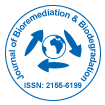Research Article
Bioremediation of a Crude Oil Polluted Soil with Pleurotus Pulmonarius and Glomus Mosseae Using Amaranthus Hybridus as a Test Plant
| Salami Abiodun Olusola1* and Elum, Ejiro Anslem2 | |
| 1Department of Crop Production and Protection, Faculty of Agriculture, Obafemi Awolowo University, Ile-Ife, Nigeria | |
| 2Institute of Ecology and Environmental Studies, Obafemi Awolowo University, Ile-Ife, Nigeria | |
| Corresponding Author : | Salami Abiodun Olusola Department of Crop Production and Protection Faculty of Agriculture, Obafemi Awolowo University Ile-Ife, Nigeria E-mail: sola1salami@yahoo.com |
| Received September 08, 2010; Accepted November 26, 2010; Published November 28, 2010 | |
| Citation: Olusola SA, Anslem EE (2010) Bioremediation of a Crude Oil Polluted Soil with Pleurotus Pulmonarius and Glomus Mosseae Using Amaranthus Hybridus as a Test Plant. J Bioremed Biodegrad 1:113. doi: 10.4172/2155-6199.1000113 | |
| Copyright: © 2010 Olusola SA, et al. This is an open-access article distributed under the terms of the Creative Commons Attribution License, which permits unrestricted use, distribution, and reproduction in any medium, provided the original author and source are credited. | |
Related article at Pubmed Pubmed  Scholar Google Scholar Google |
|
Abstract
Fallouts from crude oil pollution of soils are known to have undesirable effects on plant growth. This research attempts to study the growth of Amaranthus hybridus grown on a crude oil polluted soil bioremediated with Pleurotus pulmonarius (a white rot fungus) and Glomus mosseae (a mycorrhizal fungus). Nine different treatment factors were used while three replicates were used for each treatment in randomized Complete Block Design at the same age of the seedlings. These treatment factors include: sterilized and unsterilized soil, crude oil, mycorrhiza, mycelium of the mushroom and its spent mushroom compost. Amaranthus hybridus was cultivated in the nursery for 3 weeks by broadcasting. The seedlings were later transplanted to experimental pots of 12cm depth, containing 1000g of soil. Seedlings were left to establish properly for a week before the soil in the experimental pots were polluted with crude oil (bonny light) in 0%, 2%, 3%, 4% concentrations. These were allowed to grow for six weeks before the experiment was terminated. Data from greenhouse experiment comprising of A. hybridus grown in pots replicated thrice in both sterilized and unsterilized soils were obtained from seedlings of 9-week old A. hybridus . Plants grown on crude oil polluted unsterilized soils died within 2 weeks after pollution. The control, sterilized and unsterilized soil showed better growth when compared with the rest treatments. Growth was better in crude oil polluted soil inoculated with mycorrhiza ( Glomus mosseae ) followed by mycelium of the mushroom in both sterilized and unsterilized soil respectively. It was observed that treatment with spent mushroom compost at high % concentration of crude oil grew better than low crude oil concentration. Regression analysis revealed that percent Total Carbon (TC) decreased in crude oil polluted soils treated with mycelium of P. pulmonarius and spent mushroom compost of P. pulmonarius . Phosphorus level was found to increase in crude oil polluted samples treated with the mycorrhizal fungus eight weeks after inoculation. Duncan’s Multiple Range Test was carried out for comparison of the mean values of plant height, number of leaves and leaf area at the different crude oil concentrations. This study shows that the use of biological and supporting physical treatments to treat contaminated soil and groundwater is effective for improved land use for vegetation and plant health, yield and growth.

 Spanish
Spanish  Chinese
Chinese  Russian
Russian  German
German  French
French  Japanese
Japanese  Portuguese
Portuguese  Hindi
Hindi 
